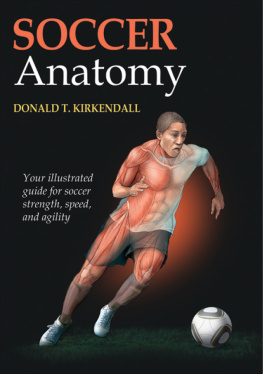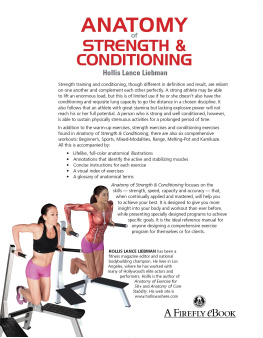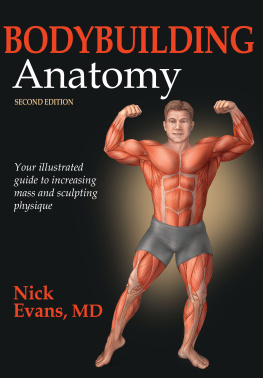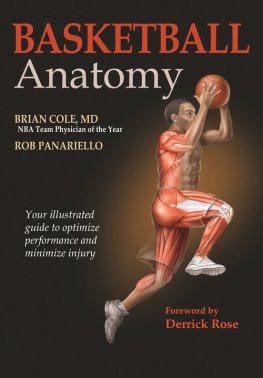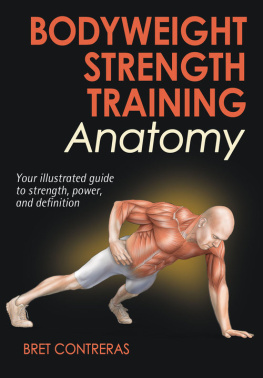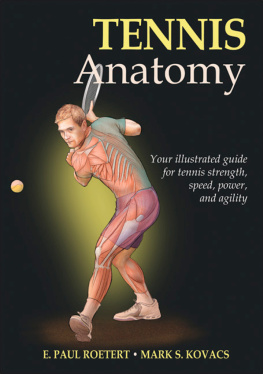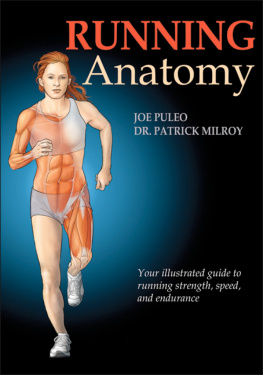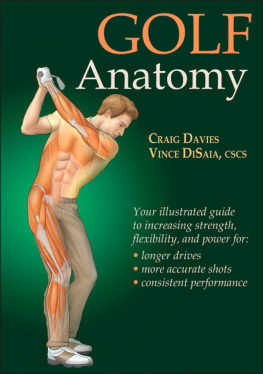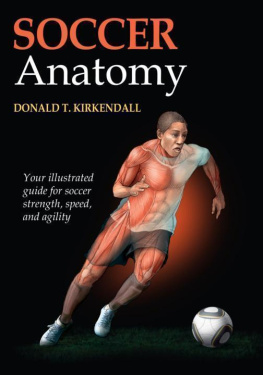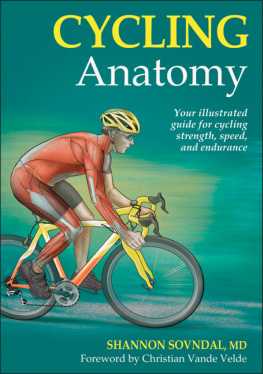SOCCER ANATOMY
Donald T. Kirkendall, PhD
Human Kinetics
Library of Congress Cataloging-in-Publication Data
Kirkendall, Donald T.
Soccer anatomy / Donald T. Kirkendall.
p. cm.
ISBN-13: 978-0-7360-9569-3 (soft cover)
ISBN-10: 0-7360-9569-1 (soft cover)
1. Soccer--Training. 2. Soccer--Physiological aspects. I. Title.
GV943.9.T7K57 2011
796.334--dc22
2011011402
ISBN-10: 0-7360-9569-1 (print)
ISBN-13: 978-0-7360-9569-3 (print)
Copyright 2011 by Donald T. Kirkendall, PhD
All rights reserved. Except for use in a review, the reproduction or utilization of this work in any form or by any electronic, mechanical, or other means, now known or hereafter invented, including xerography, photocopying, and recording, and in any information storage and retrieval system, is forbidden without the written permission of the publisher.
This publication is written and published to provide accurate and authoritative information relevant to the subject matter presented. It is published and sold with the understanding that the author and publisher are not engaged in rendering legal, medical, or other professional services by reason of their authorship or publication of this work. If medical or other expert assistance is required, the services of a competent professional person should be sought.
The web addresses cited in this text were current as of May 2011 unless otherwise noted.
Acquisitions Editor: Tom Heine; Developmental Editor: Cynthia McEntire; Assistant Editors: Laura Podeschi, Claire Gilbert; Copyeditor: Patricia MacDonald; Graphic Designer: Fred Starbird; Graphic Artist: Tara Welsch; Cover Designer: Keith Blomberg; Photographer (for soccer illustration references): Tony Quinn; Photographer (for exercise illustration references): Peter Mueller; Visual Production Assistant: Joyce Brumfield; Art Manager: Kelly Hendren; Illustration (cover): Jen Gibas; Illustrations (interior): Precision Graphics; Printer: Premier Print Group
Human Kinetics books are available at special discounts for bulk purchase. Special editions or book excerpts can also be created to specification. For details, contact the Special Sales Manager at Human Kinetics.
Printed in the United States of America 10 9 8 7 6 5 4 3 2 1
Human Kinetics
website: www.HumanKinetics.com
United States: Human Kinetics
P.O. Box 5076
Champaign, IL 61825-5076
800-747-4457
e-mail: humank@hkusa.com
Canada: Human Kinetics
475 Devonshire Road Unit 100
Windsor, ON N8Y 2L5
800-465-7301 (in Canada only)
e-mail: info@hkcanada.com
Europe: Human Kinetics
107 Bradford Road
Stanningley
Leeds LS28 6AT, United Kingdom
+44 (0) 113 255 5665
e-mail: hk@hkeurope.com
Australia: Human Kinetics
57A Price Avenue
Lower Mitcham, South Australia 5062
08 8372 0999
e-mail: info@hkaustralia.com
New Zealand: Human Kinetics
P.O. Box 80
Torrens Park, South Australia 5062
0800 222 062
e-mail: info@hknewzealand.com
Converted to eBook by EasyEPUB
Preface
P ele called it the beautiful game. The simplicity of his comment about soccer has resonated among fans of the game for decades. The beauty of soccer begins with skill. Beautiful soccer means controlling an impossible ball, such as Dennis Bergkamps 89th-minute goal in the 1998 FIFA World Cup or Maxi Rodriguezs chest-to-volley strike from the upper corner of the penalty area at the 2006 FIFA World Cup. Soccers beauty is in the perfectly paced seeing-eye pass threaded through the smallest opening in the defense, which you will see anytime Kaka (Brazil) or Xavi (Spain) is playing. Or a solo dribbling run through the defense such as Diego Maradonas 1v7 run against England in the 1986 FIFA World Cup. Or the long-range cannon shot by Paul Breitner at the 1974 FIFA World Cup.
Then there is tactical brilliance. How about the 25-pass sequence to a goal by Argentina against Serbia in the 2006 FIFA World Cup, or the lightning-fast length-of-the-field counterattack for a goal by the United States against Brazil in the 2009 FIFA Confederations Cup final? Brazils fourth goal against Italy in the 1970 World Cup is still considered a masterful display of teamwork, skill, and guile.
The objective of soccer is the same as in any other team sport: Score more than the opponent. This simple philosophy is enormously complicated. To be successful, a team must be able to present a physical, technical, tactical, and psychological display that is superior to the opponents. When these elements work in concert, soccer is indeed a beautiful game. But when one aspect is not in sync with the rest, a team can be masterful and still lose. The British say, They played well and died in beauty.
Soccer, like baseball, has suffered under some historical inertia: Weve never done that before and won. Why change? or I never did that stuff when I played. That attitude is doomed to limit the development of teams and players as the physical and tactical demands of the game advance.
And oh how the game has advanced. For example, the first reports on running distance during a match noted English professionals of the mid 1970s (Everton FC) averaged about 8,500 meters (5.5 miles). Today, most distances average between 10,000 and 14,000 meters (6 and 8.5 miles). There are reports that females, with their smaller hearts, lower hemoglobin levels, and smaller muscle mass, can cover the 6 miles attributed to men. The distance and number of runs at high speed have also increased as the pace of the game has become more ballistic and powerful. To those of us who have followed the game over the years, the pros sure do seem to strike the ball a lot harder now.
But the benefits of soccer extend beyond the competitive game. Emerging evidence shows that regular participation in soccer by adults is as effective as traditional aerobic exercise such as jogging for general health and for treating certain chronic conditions. For example, people with hypertension can see reductions in blood pressure similar to that seen in joggers. Blood fats can be reduced. Increased insulin sensitivity means those with type 2 diabetes and metabolic syndrome should see benefits. Regular soccer helps people, youths or adults, who are attempting to lose weight. A host of benefits are possible, all from playing an enjoyable game. An interesting sidenote is that when those studies were concluded, a lot of joggers just quit, but soccer players looked at each other and said, Great. Can we go play now?
The game is not as embedded in American culture as it is in other countries. Around the world, families, neighbors, and friends play the game whenever they can. In the United States, this neverending exposure to soccer is not as evident, so upon joining a team, an American child does not possess the beginnings of a skill set obtained from free play with family and friends. The coach may well be the childs only exposure to the game, requiring almost all coaching to be focused on the ball, which may neglect some basic motor skills and supplementary aspects of fitness.
In particular, the soccer communityand not just in the United Stateshas viewed supplemental strength training with skepticism. In addition, soccer players tend to view any running that is longer than the length of a field as unnecessary, and they avoid training that does not involve the ball. But give them a ball and they will run all day. The problem is many coaches apply the principle of specificity of training too literally (if you want to be a better soccer player, play soccer) and end up denying players training benefits that are proven to improve physical performance and prevent injury.

